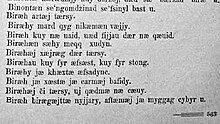Ossetian language
| Ossetian | |
|---|---|
| Ирон æвзаг (Iron ævzag) | |
| Native to | Russia (North Ossetia-Alania), South Ossetia (partially recognized), Georgia, Turkey |
| Ethnicity | Ossetians |
|
Native speakers
|
ca. 570,000 (2001 – 2010 census) |
|
Early forms
|
|
| Dialects | |
|
Cyrillic (Ossetian alphabet) Georgian (c. 1820–1954) Latin (1923–1937) |
|
| Official status | |
|
Official language in
|
|
| Language codes | |
| ISO 639-1 | os |
| ISO 639-2 | |
| ISO 639-3 | |
| Glottolog | osse1243 |
| Linguasphere | 58-ABB-a |

Ossetian text from a book published in 1935. Part of an alphabetic list of proverbs. Latin script.
|
|
Ossetian, also known as Ossete and Ossetic (endonym: Ирон æвзаг, Iron ævzag), is an Eastern Iranian language spoken in Ossetia, a region on the northern slopes of the Caucasus Mountains. It is a direct descendant of the Scythian, Sarmatian and Alanic languages.
The Ossete area in Russia is known as North Ossetia-Alania, while the area south of the border is referred to as South Ossetia, recognized by Russia, Nicaragua, Venezuela and Nauru as an independent state but by most of the rest of the international community as part of Georgia. Ossetian speakers number about 577,450, with 451,000 speakers in the Russian Federation recorded in the 2010 census.
Ossetian is the spoken and literary language of the Ossetes, a people living in the central part of the Caucasus and constituting the basic population of the republic of North Ossetia–Alania, which belongs to the Russian Federation, and of South Ossetia, which is de facto independent (but is de jure part of the Georgian Republic according to most other states). Ossetian belongs to the Iranian group of the Indo-European family of languages. Within Iranian it is placed in an Eastern subgroup and further to a Northeastern sub-subgroup, but these are areal rather than genetic groups. The other Eastern Iranian languages such as Pashto and Yaghnobi show certain commonalities but also deep-reaching divergences from Ossetic.
...
Wikipedia
